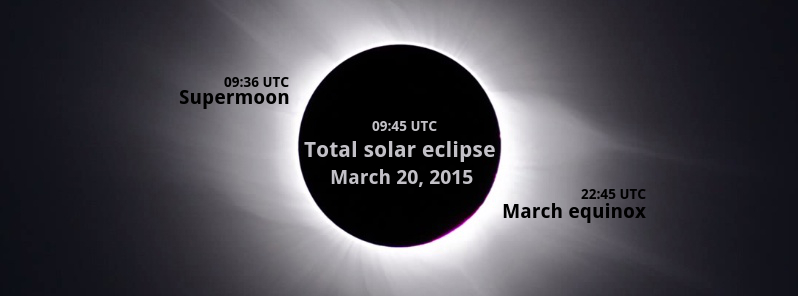Supermoon, total solar eclipse and March equinox on March 20, 2015

A supermoon, total solar eclipse and March equinox will all occur during March 20, 2015.
The Moon will turn new at 09:36 UTC which is about 13.5 hours after reaching its closest point to our planet (lunar perigee) and will thus appear larger in size and have a larger than average effect on our oceans (supermoon).
It will be located on the same side of the Earth as the Sun and will not be visible from our planet, but it will set stage for the first total solar eclipse since November 3, 2013, and the last total solar eclipse visible in Europe until August 12, 2026.
At 22:45 UTC, the Sun will shine directly on the equator and there will be nearly equal amounts of day and night throughout the world. This will be the first day of spring (vernal equinox) in the Northern Hemisphere and the first day of fall (autumnal equinox) in the Southern Hemisphere.
Total solar eclipse of March 20, 2015
The path of totality for this eclipse will be limited to the North Atlantic and Arctic Oceans between Greenland and northern Russia which means skywatchers in Europe, northern Africa, and northwestern Asia will be treated to a partial solar eclipse.
The longest duration of totality will be 2 minutes 47 seconds (at 09:45:24 UTC) off the coast of the Faroe Islands, in the Norwegian Sea. Moon's shadow will resemble a huge eclipse about 463 km (288 miles) wide and 150 km (93 miles) long.
The only populated places, reachable by public travel, where the totality can be seen are the Faroe Islands and Svalbard archipelago. Unfortunately, chances for a clear sky there will be pretty slim.
Eclipse map predictions courtesy of Fred Espenak, NASA/Goddard Space Flight Center
The partial eclipse (from ~50% to nearly 99% of the Sun’s diameter) will reach maximum in:
- Madrid at 9:09 UTC (66% totality),
- Dublin at 9:28 UTC (91% totality),
- Paris at 9:29 UTC (78% totality),
- London (84% totality) and Rome (53% totality) at 9:31 UTC,
- Reykjavik at 9:37 UTC (98% totality),
- Munich at 9:39 UTC (67% totality),
- Oslo at 9:53 UTC (88% totality),
- Bucharest at 9:56 UTC (43% totality),
- Warsaw at 9:57 UTC (66% totality),
- Kiev (52% totality) and Helsinki (78% totality) at 10:08 UTC,
- Moscow at 10:20 UTC (57% totality).
You can find eclipse times for other cities in Europe here, and eclipse times in the Atlantic, Africa and Asia here.
- This interactive eclipse path made by NASA using Google Maps will show you the path of the solar eclipse across Earth's surface and make it really simple to find exact times (start, max, end), magnitude and obscuration for any part of the world where total or partial solar eclipse can be seen. Just zoom in and click on any part of the map, then use any online time converting tool to convert UTC to your time zone.
Impacts
The European Network of Transmission System Operators for Electricity (ENTSOE) has prepared an impact analysis of the March 20, 2015 total solar eclipse on the European Union's power system.
With about 90 GW of solar power in use, the reduction in solar radiation will directly affect the output of the photovoltaics and for the first time this is expected to have a relevant impact on the secure operation of the European power system.
They estimated a temporary decrease by more than 30 GW if the sky is clear and have taken measures to mitigate the impact. The power gradient (change in power) may be −400 MW/minute and +700 MW/minute. Their full impact analysis can be found here.
In a study done by S. L. Gray , R. G. Harrison titled "Diagnosing eclipse-induced wind changes" and published on May 25, 2012 in the Proceedings of the Royal Society of London, the temperature may decrease by up to 3 °C, and wind power may somewhat decrease as mean regional winds are slightly reduced during the maximum eclipse hour. The study can be found here.
Where to watch it online
The online Slooh Community Observatory will send an expedition team to the North Atlantic and broadcast live views of the solar eclipse in a show beginning at 08:30 UTC.
The Virtual Telescope Project will broadcast live views of the eclipse in their show starting at 08:15 UTC.
Warning
Do not attempt to observe the partial or annular phases of any eclipse with the naked eye. Failure to use appropriate filtration may result in permanent eye damage or blindness!
Featured image: Background image credit: NASA/Goddard. Edit: The Watchers

Wow sounds fun! Sad we didn’t see it here in London.
Yes..a good report. I must warn people to respect these changes happenings. Preventives m.ust be taken by expecting women.from 1.10 pm IST to 5.10pm
Wow great article! I have written something similar in my blog about the big shifts happening this Friday.. I have noticed a lot of emotions coming up and so have many people around me.
http://mindandbodyhealth.com/solar-eclipse-on-march-20-2015-rare-alignment-of-moon-and-sun/
Time to buy a lottery ticket! This is not coincidence!